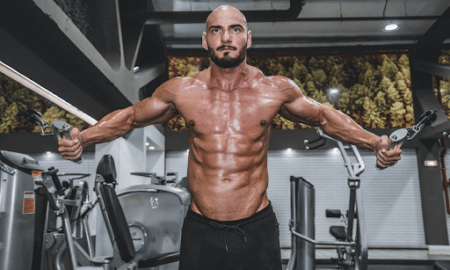Are the gains in muscle size and strength stimulated by anabolic steroid use permanent or temporary? During the early years of athletic steroid use, medical texts frequently attributed muscle-size gains to “water retention.” While some water retention is clearly associated with steroid use, the drugs also produce genuine gains in muscle size and strength. The disconnect between what appeared to be obvious and what the scientists were saying about steroids—that the gains were illusory—initiated a distrust of the medical profession in regard to anabolic drug use that still exists today.
The question about steroid-induced gains is pertinent for several reasons. For one, there are clear differences between athletes on drug regimens and the same athletes when they’re not taking the drugs. Years ago many pro bodybuilders would appear to deflate within two months of competing in a major contest. Their massive size and intense muscular definition would rapidly recede to more normal dimensions. That, of course, led to the belief that steroid use was primarily responsible for their muscularity. Loss of muscle size held true for nearly all the top bodybuilders, with the notable exception of those who claimed to be drug-free.
The apparent loss of muscle mass isn’t as common today. Rather than getting smaller after shows, most current champion bodybuilders appear larger, though considerably less defined. The gain in postcontest size is caused by several factors. For one, most competitive bodybuilders dehydrate themselves prior to contests in order to maximize muscular definition. They also have extremely low bodyfat, again to produce the appearance of highly defined muscle. What you’re left with is pure muscle and bone, along with a skin covering. I haven’t looked at IFBB rules lately, but I have a feeling that competing without skin may be against the rules, besides being incompatible with life. When the contest ends, bodybuilders usually return to more normal eating habits, which rapidly add both water and, in many cases, bodyfat.
One reason anabolic steroids increase muscle size is that they competitively inhibit the interaction between cortisol and its cellular receptors. Cortisol is the primary catabolic steroid, responsible for loss of muscle size and strength. It’s the yin to testosterone’s yang. If you inhibit cortisol, you tip the cellular balance toward anabolism—building muscle and strength. After a period of being on an extensive steroid regimen, then getting off, you risk your muscles’ being flooded with active and open cortisol receptors. You don’t need a science degree to realize that this portends a rapid loss of muscle size and strength.
Many bodybuilders are aware of the increased cortisol activity. To offset it, some stay on low doses of anabolic steroids year-round or use other substances, such as growth hormone, that they hope will counter cortisol. There are problems with that approach, however. The chance of serious side effects linked to any drug is related to both dosage and frequency of use. Going off anabolic steroids gives the body time to recuperate from any harmful effects, especially those related to liver and cardiovascular function. Conversely, staying on the drugs, even at a lower dose, doesn’t give the body a chance to detoxify. The likelihood of serious side effects is greatly increased.
A recent study presented at a science conference points to an unexpected finding about athletic steroid use: It changes muscle physiology to the extent that you can make greater-than-normal gains even years after you stop using all anabolic drugs.1 Researchers examined the use of steroids in powerlifters, specifically focusing on two muscle groups: the vastus lateralis of the upper thighs and the trapezius of the upper back. Three groups were examined:
1) Seven powerlifters who had previously used anabolic steroids for long periods but stopped using them years ago
2) Active powerlifters who were not using steroids
3) Active powerlifters who were using steroids
Various aspects of muscle structure were closely observed in all the groups. Even years after not engaging in heavy lifting or using steroids, the athletes in group 1 had muscle fibers and nuclei per fiber that were comparable to those still actively engaged in intense, heavy training. The fibers in the neck-and-shoulder area of those in group 1 showed even more muscle nuclei than the current steroid users. The authors noted that having those additional muscle nuclei would be beneficial for those who continued to train because the nuclei would spur additional muscle protein synthesis, which translates into a more efficient pathway to size and strength.
In simple terms, using anabolic steroids changes muscle anatomy to the extent that it primes the muscle to make gains even long after athletes have stopped using the drugs. Relating that information back to the original question of whether steroid gains are retained, the answer would be yes, but with a caveat. A major reason that steroid-induced gains appear to evaporate when the drugs are stopped is that many athletes either lay off all training after a contest or severely cut back on intensity. Inactivity amplifies cortisol’s effect and can cause muscle loss. On the other hand, if athletes continus to train with high intensity, there’s no reason their muscle gains would disappear.
Aerobics: A Cure for Steroid Side Effects?
While permanent side effects linked to extensive anabolic steroid use are relatively rare, it’s nonetheless true that steroids exert their most potent negative effects on the liver and cardiovascular system. Studies show that steroids are linked to the development of high blood pressure, damage to the heart muscle, heart rhythm disturbances, interference with clotting factors in the blood and heart failure. In addition, using an extensive steroid array adversely affects cardiovascular risk factors. Steroids, especially oral versions, are known to lower protective high-density lipoprotein, or HDL, as well as its protein backbone, apolipoprotein A1. At the same time, steroids increase plasma low-density lipoprotein, or LDL, which is directly linked to cardiovascular disease. A major benefit of exercise is that it favorably affects those lipoproteins, raising HDL and lowering LDL.
Many doctors wrongly advise patients that testosterone is bad for the heart. In fact, it offers many beneficial cardiovascular effects. Mice lacking sufficient testosterone show increased LDL and lower HDL, exactly the picture you see with big-time steroid use in humans. Wild mice are naturally low in LDL and high in HDL. So scientists developed a transgenic mouse model by adding a certain protein not found in wild mice but common in humans. The manipulation of mouse genes enabled the scientists to produce a mouse that mimicked cardiovascular disease in humans.
In a recent study, a group of researchers wanted to examine the effects of anabolic steroids on cardiac structure and plasma lipoprotein profiles.2 They used the transgenic mice that are prone to a similar level of cardiovascular risk as humans. The mice were divided into four groups:
1) Exercise and mesterolone, an anabolic steroid (trade name Proviron)
2) Exercise and a placebo
3) Sedentary and mesterolone
4) Sedentary and a placebo
The exercise consisted of treadmill running, five days a week for 60 minutes per session for six weeks. Compared to the sedentary mice getting the placebo, the mice that didn’t exercise but were given mesterolone showed significant elevations of triglycerides (blood fat) total cholesterol, LDL and VLDL (a precursor of LDL). When exercise was added, the mice were higher in HDL and lower in VLDL and triglycerides. The exercise also increased blood flow in the heart, but that effect was slightly reduced in the mice on steroids. While exercise alone produced favorable effects in heart muscle structure and function, they were was blocked in the steroid mice. The net effect is that while doing aerobic exercise may partially reduce a few of the major cardiovascular risk factors raised by steroid use, steroids also interfere with the favorable changes in heart muscle structure induced by aerobic exercise. Studies of men using Proviron for six months show similar negative cardiovascular risk factor changes—lower HDL, increased LDL and total cholesterol.
Proviron is weak compared to other steroids and is most commonly used by athletes to combat the effects of excess estrogen that other anabolic steroids produce. Proviron may bind to aromatase, the enzyme that converts androgens into estrogens in the body. It binds to sex-hormone-binding globulin, the primary binding protein of testosterone in the blood. So Proviron may boost the potency of other steroids, particularly testosterone. On the negative side, while Proviron doesn’t convert into estrogen as many other steroids do—and may even lower estrogen levels—it’s a DHT-based steroid. That means it’s structurally similar to dihydrotestosterone, the cause of such side effects as male-pattern baldness, acne and prostate enlargement.
A Meaty Problem
Several world-class athletes who’ve tested positive for anabolic steroids have loudly proclaimed their innocence. In some cases the positive drug tests have been traced to contaminated food supplements. That was particularly true when pro-hormone supplements were on the market. Some companies mixed various supplements in the same batch, which meant that trace amounts of pro-hormones were surreptitiously added to such innocent sports supplements as creatine. In other cases actual drugs, including anabolic steroids and clenbuterol, were purposely added to supplements. That was more prevalent in supplements purchased on the Internet or manufactured overseas, rather than in American-produced products.
According to a new report, there may be another source of steroid contamination: food. During the recent Summer Olympic games in Beijing, an American Olympic athlete found an oversize chicken breast in a local supermarket. Analysis of the monster meat showed that it contained enough anabolic steroids to produce a positive result on a drug-test screen. That isn’t a new phenomenon, as anabolic drugs have been illegally given to animals for some time. In one instance in Spain more than 100 people came to local hospitals complaining of heart problems. It turned out that they’d been eating meat that was contaminated with clenbuterol, a drug that has potent cardiovascular effects.
In a 1994 study, chicken was injected with an anabolic steroid called methenolone—trade name Primobolan—for purposes of fattening. It was injected intramuscularly three times over 14 days. Eight days after the third injection, the meat was cooked and eaten. Four out of eight people who ate the “supplemented” chicken tested positive for a metabolite of Primobolan 24 hours after eating it.
In a 1992 study a subject who ate raw minced meat tested positive for the anabolic steroid clostebol. Since anabolic steroids are stable in heat, cooking the meat doesn’t deactivate them. Another study a year later found that minced meat obtained from 50 butchers all over Belgium led to positive doping tests for the steroids nandrolone and clostebol in two subjects who ate the beef. Eating boar meat, which can contain high amounts of naturally occurring nandrolone, is enough to produce a positive doping test.
So it appears that at least in some cases, those who proclaim their innocence after testing positive for steroids may have a legitimate beef.
References
1 Eriksson, A., and Thornell, L. (2008). Anabolic steroids withdrawal in strength-trained athletes: How does it affect skeletal muscles? Paper presented at the Integrative Biology of Exercise V Conference of the American Physiological Society, September 2008, in Hilton Head, South Carolina.
2 Fontana, K., et al. (2008). Adverse effect of the anabolic-androgenic steroid mesterolone on cardiac remodelling and lipoprotein profile is attenuated by aerobic exercise training. Int J Exp Path. 89:358-366. IM




















You must be logged in to post a comment Login